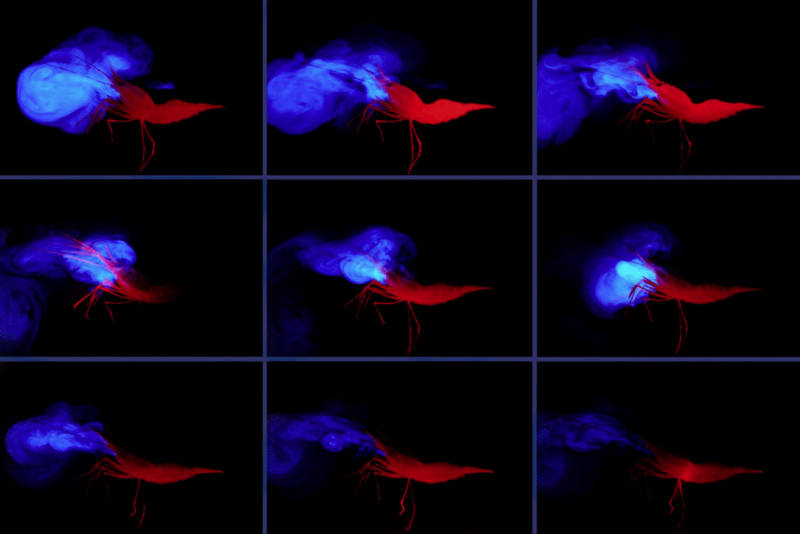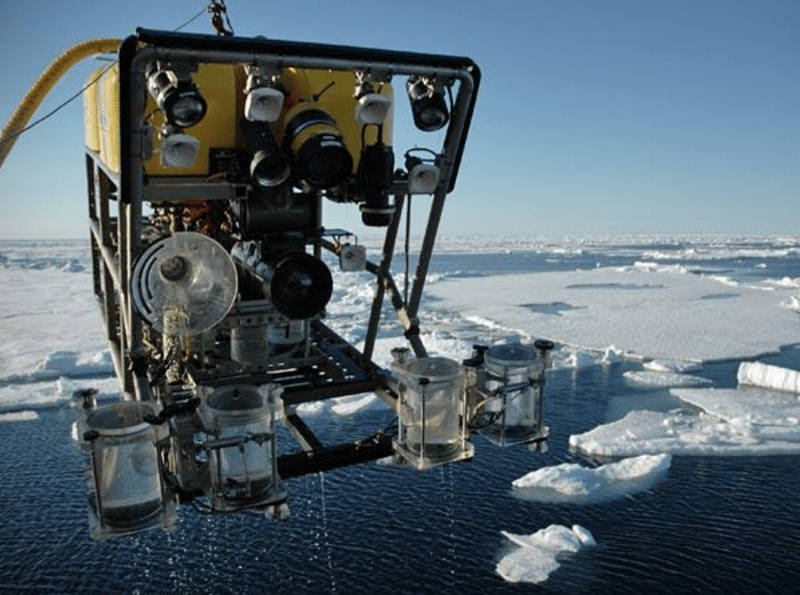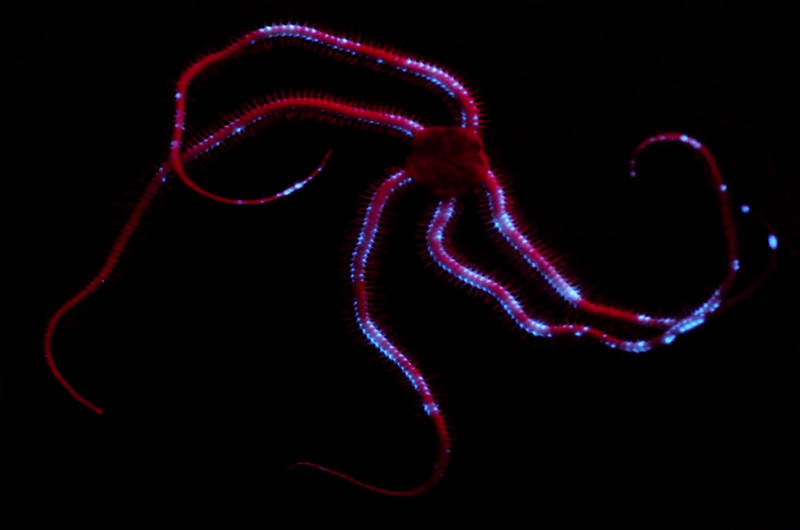
By Sönke Johnsen, Professor of Biology - Duke University

Sequence of the deep-sea pandalid shrimp Heterocarpus ensifer ‘vomiting’ light from glands located near its mouth. Image courtesy of Journey into Midnight: Light and Life Below the Twilight Zone. Download larger version (jpg, 53 KB).
We lead our lives guided and constrained by structures and rules that are so deeply embedded that we often forget they are there. Consider roads. Nearly all of us go to school, work, or the store by walking, biking, or driving down a road. Without our even thinking of it, these roads decide where we go and how we will get there. They are efficient of course, but they also limit us. Except for the occasional child cutting across a field or a neighbor’s backyard, we’re all moving along that asphalt in our daily lives. But what if the roads went away? How would our lives change? More generally, what happens in nature when a restricting force is taken away and animals are free to change in new ways?

Sonke Johnsen, Justin Marshall, and Mark Hooper blue-water diving in the Bahamas. Image courtesy of Journey into Midnight: Light and Life Below the Twilight Zone. Download larger version (jpg, 47 KB).
Our mission for this expedition is to explore what happens to deep-sea animals when a very important constraint is taken away from them – that of light. Most of us see the ocean from the beach, where it is a green and murky thing. Those of us who live in Hawaii or parts of Florida see that water as more blue-green, but nobody on land sees the ocean as it truly is – a shockingly pure and intense shade of blue.
The open ocean looks like this because it absorbs light of all the other colors far more strongly, leaving only the blue, especially at depths greater than about 30 meters (100 feet). This light, for those who have seen it from submersibles or open-ocean diving, is beautiful like nothing else, but for the animals living at depth, it limits them the ways roads limit us.
Like the old joke, “you can buy this car in any color as long as it’s black,” the animals who want to see the dim light that filters through the water must see it in blue. Therefore, few of them have color vision and nearly all have a visual system that is most sensitive to blue light. Because these eyes are tuned to blue light, this means that nearly all bioluminescence must be blue as well, or it won’t be seen. This makes for a beautiful but limited color palette, which makes it hard for an animal to be recognized by its own species by, for example, sending out a beam of red light.
However, at a depth of about 1,000 meters (3,280 feet), this limitation goes away because the downwelling blue sunlight is too dim to see. The only remaining light is bioluminescence. Therefore, animals are no longer forced to only be sensitive to blue, and their eyes – and their light emissions – may branch out to other parts of the rainbow. There is some evidence from previous expeditions to these greater depths that this occurs, but nobody has looked at it in detail. So, our goal is to explore this dark world, where the limiting rules of blue sunlight no longer apply and animals are free to wander in larger color space. In particular, we are interested in the visual systems and bioluminescence of the animals that live here.

Although we won’t be working in Antarctica, this image shows the same remotely operated vehicle Global Explorer that we will be using on our expedition. Image courtesy of Journey into Midnight: Light and Life Below the Twilight Zone. Download larger version (jpg, 120 KB).
We will examine this world in several ways. First, using the Global Explorer remotely operated vehicle (ROV), we will run transects at depths between 915 and 1,830 meters (3,000 and 6,000 feet), taking still and video images, along with low-light video to study the bioluminescence. The ROV also has collecting apparatus that allows us to collect some of the slower-moving animals to examine on the ship.
Second, we will use a 100-foot-long custom-built trawl net to collect animals at these depths, again for examination aboard the ship. Finally, we will deploy the Medusa camera system (the one that caught some of the first footage of giant squid), which will drift along by itself at these great depths, collecting imagery in a way that disturbs the animals less than a camera or a net would.

Bioluminescence of the ophiuroid Ophiochiton ternispinus found at 3000 feet depth off the Bahamas. Image courtesy of Journey into Midnight: Light and Life Below the Twilight Zone. Download larger version (jpg, 34 KB).
The animals that are brought on board will be examined in multiple ways. First, we will take natural color low-light images of their bioluminescent emissions using techniques developed on previous NOAA Office of Ocean Exploration and Research cruises. At the same time, using specialized low-light spectroscopy equipment, we will measure precisely how much light of each color is emitted by the animal.
The visual systems will be studied in two ways. First, certain crustaceans will be placed in a machine that can measure the extremely small electrical signals that are generated by the eyes when they see a flash of light. This technique can then be used to determine what colors the eyes are most sensitive to. Second, tissue saved from many species can be examined after the cruise to determine which vision genes are expressed. This information again can tell us what colors the animals may be able to see.
We also will be examining certain groups (shrimp, fish, squid) in detail for the structure of their photophores, the color of their bodies, and the structure of the eyes – all to better understand how the animals both make and see color.

During the expedition, the team will explore the water column over the deep abyssal plain between the Mississippi Fan and the West Florida Shelf. Image courtesy of Journey into Midnight: Light and Life Below the Twilight Zone. Download image (jpg, 134 KB).
After two days of getting the ROV and its control van situated on the back of the ship (June 6 and 7), we will begin a long and slow transit to to our exploration site over the deep abyssal plain in the middle of the Gulf of Mexico. The escarpment is essentially a long cliff that separates shallower water from deeper water in the Gulf of Mexico. The waters here will be at least 2,135 meters (7,000 feet) deep, giving us plenty of room to work. Because all of our work will be done in the water column and not on the bottom, we don’t have a specific site (such as a deep-sea coral reef) that we will be visiting.
The daily plan will be to dive the ROV all day, collecting as much video footage as possible. We will then recover the ROV and deploy the net (and on certain days the Medusa) for the evening and night, likely working well until morning. Time on a ship is precious and we plan to make the most of it. Sometime on June 22, we will be out of this time and will sail back to Gulfport, Mississippi, for a day’s work of getting the equipment and the ROV back off the ship.
If all goes well, we should be able to make one of the first detailed explorations of the visual world of animals below 1,000 meters (3,280 feet), a world that we think has the potential to be exceptionally exciting. We look forward to sharing the discoveries on a daily basis via our mission logs.